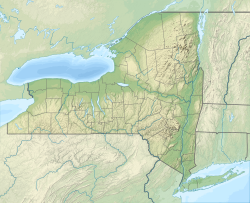| Temple B'rith Kodesh | |
|---|---|
 The synagogue interior in 2019 | |
| Religion | |
| Affiliation | Reform Judaism |
| Ecclesiastical or organisational status | Synagogue |
| Leadership |
|
| Status | Active |
| Notable artworks | Salvador Dalí-designed menorah |
| Location | |
| Location | 2131 Elmwood Avenue, Brighton, Rochester, Monroe County, New York 14618 |
| Country | United States |
Location in New York | |
| Coordinates | 43°7′28″N77°34′46″W / 43.12444°N 77.57944°W |
| Architecture | |
| Architect | Pietro Belluschi |
| Type | Synagogue |
| Established | 1848 (as a congregation) |
| Completed | 1962 |
| Website | |
| tbk | |
Temple B'rith Kodesh is a Reform Jewish synagogue located at 2131 Elmwood Avenue, in the suburb of Brighton, in Rochester, Monroe County, New York, in the United States. It is the oldest synagogue and the largest Reform congregation in the greater Rochester area. [1]
